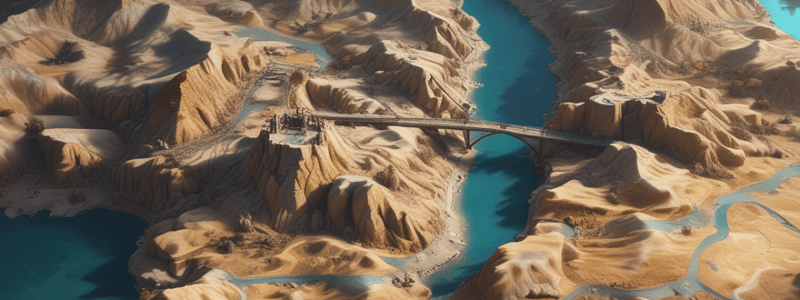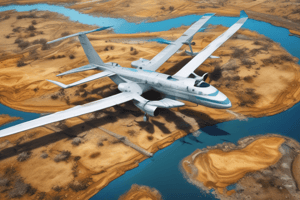Podcast
Questions and Answers
A laptop with an RTX 2070, i7 processor, and 16GB of RAM is suitable for handling large image sets.
A laptop with an RTX 2070, i7 processor, and 16GB of RAM is suitable for handling large image sets.
False (B)
Direct mount storage allows for slower access to files and slower workflow.
Direct mount storage allows for slower access to files and slower workflow.
False (B)
HDDs are recommended for their fast performance and reliability.
HDDs are recommended for their fast performance and reliability.
False (B)
IPS-rated monitors are necessary for gaming only.
IPS-rated monitors are necessary for gaming only.
Asking for discounts from small businesses can help their profits.
Asking for discounts from small businesses can help their profits.
Study Notes
Understanding Equipment for Photogrammetry Applications
- There are different types of photogrammetry applications:
- Acquisition applications (e.g., Drone Deploy) for controlling drones to fly autonomous missions and acquire images for mapping
- Desktop processors or processing engines (e.g., Pix 4D) for creating point clouds, meshes, and deliverables
- Cloud-based applications that combine acquisition and processing
- The choice of equipment and processing software depends on the industry vertical, deliverables, and workflow
Types of Processing Engines
- Desktop processors (e.g., Pix 4D) require a powerhouse machine with significant processing power, RAM, and storage
- Cloud-based processors (e.g., Drone Deploy) do not require high-end computers, but may have limitations in terms of deliverables and verticals
Understanding Deliverables
- Different industries require different deliverables (e.g., contour lines, 2D rapid orthomosaics, 3D meshes)
- The processing engine and equipment needed depend on the deliverables required
- Flexibility is important, especially for drone service providers, to accommodate different client needs
Computers for Processing Maps
- A dedicated machine is recommended for processing maps to avoid slowing down other tasks
- Consider the CPU, motherboard, RAM, GPU, and storage when choosing a computer for processing maps
- Research websites like Puget systems can provide valuable insights on the best configurations for specific software and deliverables
Pix 4D Mapper
- Pix 4D Mapper can be used on a Mac, but may have glitches and limitations
- Using Boot Camp or Parallels can resolve some issues, but may still have errors and limitations
- Matt Schaer recommends using a 16-inch MacBook Pro (2020 model) for mapping
Hardware Components
- CPU: AMD is a good option for the money, but consider the ecosystem when choosing components
- Motherboard: Choose a reputable brand, ensure it has multiple ports for adding GPUs, and max out on features for future upgrades
- RAM: Get a minimum of 64 GB for mapping, and the highest speed possible
- GPU: Get the highest-end GPU possible, and ensure it's CUDA-enabled for Pix 4D
- Storage: Get a lot of storage, and consider having multiple M.2 slots on the motherboard
- Cooling: Keep the computer cool, consider liquid cooling, and ensure good airflow
RAM and Memory
-
RAM is like acute memory, quickly accessible for decision-making
-
Get a minimum of 64 GB of RAM for mapping, and consider 128 GB or more for heavy usage
-
Speed is also important, get the highest speed possible### Computer Components for Drone Mapping
-
The GPU is crucial for processing, and having more RAM allows it to process more data.
-
The RTX 2070 card is a good option, but consider getting the RTX 2080 TI for better performance.
-
The GeForce GTX 1080ti card has 11GB of RAM, compared to the RTX 2070's 7GB.
Storage
- Direct mount storage allows for faster access to files and faster workflow.
- Ensure the read and write speeds are above 3000 megabits per second.
- Avoid cables, as they can downgrade bus speed.
- SATA SSDs are a good alternative if direct mounted storage is not feasible.
- HDDs are not recommended due to their slower performance and potential for data loss.
Power Supply
- Get a power supply that is more than what you need to ensure you have enough power when the computer is under load.
Case and Cooling
- A basic case is sufficient for building a desktop, as you'll be taking everything off and pushing air through it.
- Consider getting LEDs for your computer from monoprice.com.
Monitors
- An IPS-rated monitor is essential for accurate color representation and calibration.
- IPS-rated monitors are necessary for drone mapping, video editing, and photography.
Building a Computer
- A budget rig for drone mapping can be built for around $1000, but it's recommended to spend more for better performance.
- Consider building a mid-range or high-end computer for better performance.
- Laptops can be a good option for mobile processing, especially Alienware laptops.
Laptops
- Alienware laptops are recommended for mobile processing and have good performance.
- A laptop with an RTX 2070, i7 processor, and 16GB of RAM can handle mapping tasks, but may not be suitable for large image sets.
Profit Margin and Supporting Small Businesses
- Buying from small businesses can support the community and provide better profit margins.
- Avoid asking for discounts from small businesses, as it can hurt their profits.
- Support small businesses by buying their products at full price.
Equipment for Photogrammetry Applications
- Photogrammetry applications include acquisition, desktop processing, and cloud-based applications that combine both
- The choice of equipment and processing software depends on the industry, deliverables, and workflow
Processing Engines
- Desktop processors require powerful machines with significant processing power, RAM, and storage
- Cloud-based processors do not require high-end computers but may have limitations in terms of deliverables and industries
Deliverables
- Different industries require different deliverables (e.g., contour lines, 2D rapid orthomosaics, 3D meshes)
- Flexibility is important, especially for drone service providers, to accommodate different client needs
Computers for Processing Maps
- A dedicated machine is recommended for processing maps to avoid slowing down other tasks
- Consider CPU, motherboard, RAM, GPU, and storage when choosing a computer for processing maps
Recommended Computer Configuration
- CPU: AMD is a good option for the money
- Motherboard: Choose a reputable brand, ensure multiple ports for adding GPUs, and max out on features for future upgrades
- RAM: Minimum 64 GB for mapping, highest speed possible
- GPU: Highest-end GPU possible, CUDA-enabled for Pix 4D
- Storage: Lot of storage, multiple M.2 slots on motherboard
- Cooling: Keep computer cool, consider liquid cooling, and ensure good airflow
Importance of RAM and Memory
- RAM is like acute memory, quickly accessible for decision-making
- Minimum 64 GB of RAM for mapping, 128 GB or more for heavy usage
- Speed is important, get highest speed possible
Computer Components for Drone Mapping
- GPU is crucial for processing, more RAM allows processing more data
- RTX 2070 card is a good option, but consider getting RTX 2080 TI for better performance
- GeForce GTX 1080ti card has 11GB of RAM, compared to RTX 2070's 7GB
Storage Options
- Direct mount storage allows for faster access to files and faster workflow
- Ensure read and write speeds are above 3000 megabits per second
- Avoid cables, SATA SSDs are a good alternative if direct mounted storage is not feasible
- HDDs are not recommended due to slower performance and potential for data loss
Power Supply and Case
- Get power supply that is more than what you need to ensure enough power when computer is under load
- Basic case is sufficient for building a desktop, consider getting LEDs for your computer
Monitors
- IPS-rated monitor is essential for accurate color representation and calibration
- IPS-rated monitors necessary for drone mapping, video editing, and photography
Studying That Suits You
Use AI to generate personalized quizzes and flashcards to suit your learning preferences.
Description
Learn about different types of photogrammetry applications, including acquisition and processing software, and how to choose the right equipment for your needs. Understand the role of drones, desktop processors, and cloud-based applications in photogrammetry.





